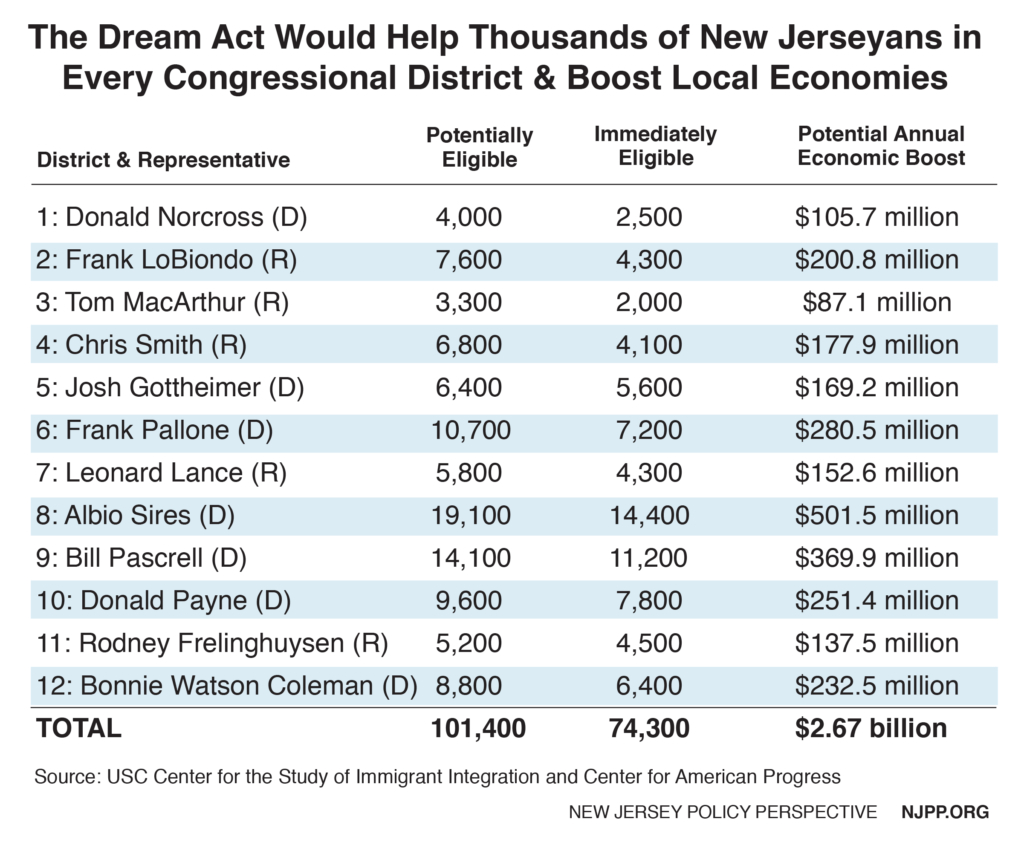To read a PDF version of this report, click here.
When President Trump ended the Deferred Action for Childhood Arrivals program earlier this year, he left almost 800,000 DACA recipients – including 17,400 New Jerseyans – to face an unknown future.[1] Now Congress must act to protect these and other young, striving immigrants by passing the Dream Act of 2017.[2] Doing so could brighten the futures of tens of thousands of young New Jerseyans while boosting the state’s economy. However, a Congressional fix for young immigrants should not be used as a vehicle for increased spending to increase border enforcement, expand immigrant detention, further militarize border communities or build a wall on the southern border.
Tens of Thousands of New Jerseyans Would Have Brighter Futures
An estimated 101,000 New Jerseyans could benefit from the Dream Act of 2017. These are people who entered the U.S. before they turned 18 and have been in the country for four continuous years.
Of these New Jerseyans, 74,000 would immediately qualify for Conditional Permanent Residence (CPR) status under the law.[3] This is the first step in the bill’s process for becoming a legal permanent resident (LPR).
Of the New Jerseyans who could benefit from the Dream Act, 61,000 are in the workforce; this is the seventh highest of all the states.[4]
These New Jerseyans live all over the state, with thousands of eligible young immigrants residing in every Congressional District.
New Jersey’s Economy Would Benefit
Passing the Dream Act and putting these New Jerseyans on a path to legal status could boost the state’s economy by at least $800 million each year – the sixth largest increase of all the states.[5]
The longer-term payoff for New Jersey’s economy is even greater. For example, if just half of the working New Jerseyans who are eligible for the Dream Act complete the transition from CPR status to LPR status by pursuing additional education, New Jersey’s economy would see an economic boost of up to $2.7 billion each year[6] – this impact is spread throughout all Congressional Districts, with every District but one seeing an economic benefit of $100 million or more.
 Eventually, the economic boats lifted by the rising tide of the Dream Act would modestly boost the average incomes of all Americans by $82-$273 a year.[7]
Eventually, the economic boats lifted by the rising tide of the Dream Act would modestly boost the average incomes of all Americans by $82-$273 a year.[7]
Nearly 3 in 4 New Jerseyans (72 percent) who could benefit from the Dream Act and are in the workforce work in five industries: wholesale and retail, leisure and hospitality, construction, manufacturing, and education and health services. These five industries would see a large chunk of the economic gains from the Dream Act as well.
Without the Dream Act, New Jersey Would Suffer
The consequences to New Jersey of the Dream Act not becoming law are dire:
Without a DACA fix, tens of thousands of young New Jerseyans would lose work permits and protection from deportation over the next two and a half years.
The loss of DACA alone would cause New Jersey’s economy to lose an estimated $1.6 billion each year – the fifth largest dollar loss of all states.[8]
It would also make more immigrants vulnerable to wage theft, workplace exploitation and discrimination based on their legal status; lead to economic distress in many households that invested in buying homes, businesses and other investments; and create a higher risk of family separation and deportation.
Endnotes
[1] New Jersey Policy Perspective, Fast Facts: DACA Directive Dims the Future of Thousands of Young New Jersey Immigrants, September 2017. https://www.njpp.org/reports/fast-facts-daca-directive-dims-the-future-of-thousands-of-young-new-jersey-immigrants
[2] Dream Act of 2017, S. 1615, 115 Congress, https://www.congress.gov/bill/115th-congress/senate-bill/1615/text, 2017.
[3] USC Center for the Study of Immigrant Integration analysis of pooled 2010-2014 American Community Survey microdata from IPUMS-USA. http://dornsife.usc.edu/csii/interactive-map-dream-act-2017/
[4] Ibid 3
[5] Center for American Progress. The State-by-State Economic Benefits of Passing the Dream Act, October 2017. https://www.americanprogress.org/issues/immigration/news/2017/10/26/441298/the-state-by-state-economic-benefits-of-passing-the-dream-act/
[6] Ibid 5
[7] Center for American Progress. The Economic Benefits of Passing the Dream Act, September 2017. https://www.americanprogress.org/issues/immigration/reports/2017/09/18/439134/economic-benefits-passing-dream-act/
[8] Center for American Progress, A New Threat to DACA Could Cost States Billions of Dollars, July 2017. https://www.americanprogress.org/issues/immigration/news/2017/07/21/436419/new-threat-daca-cost-states-billions-dollars/


